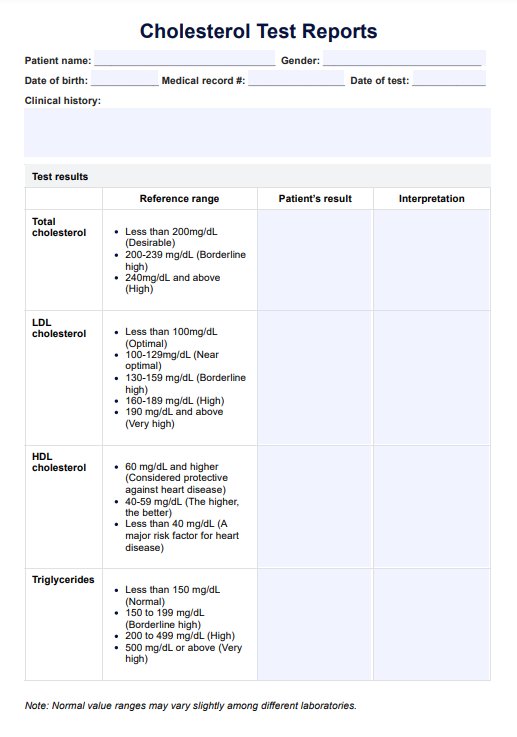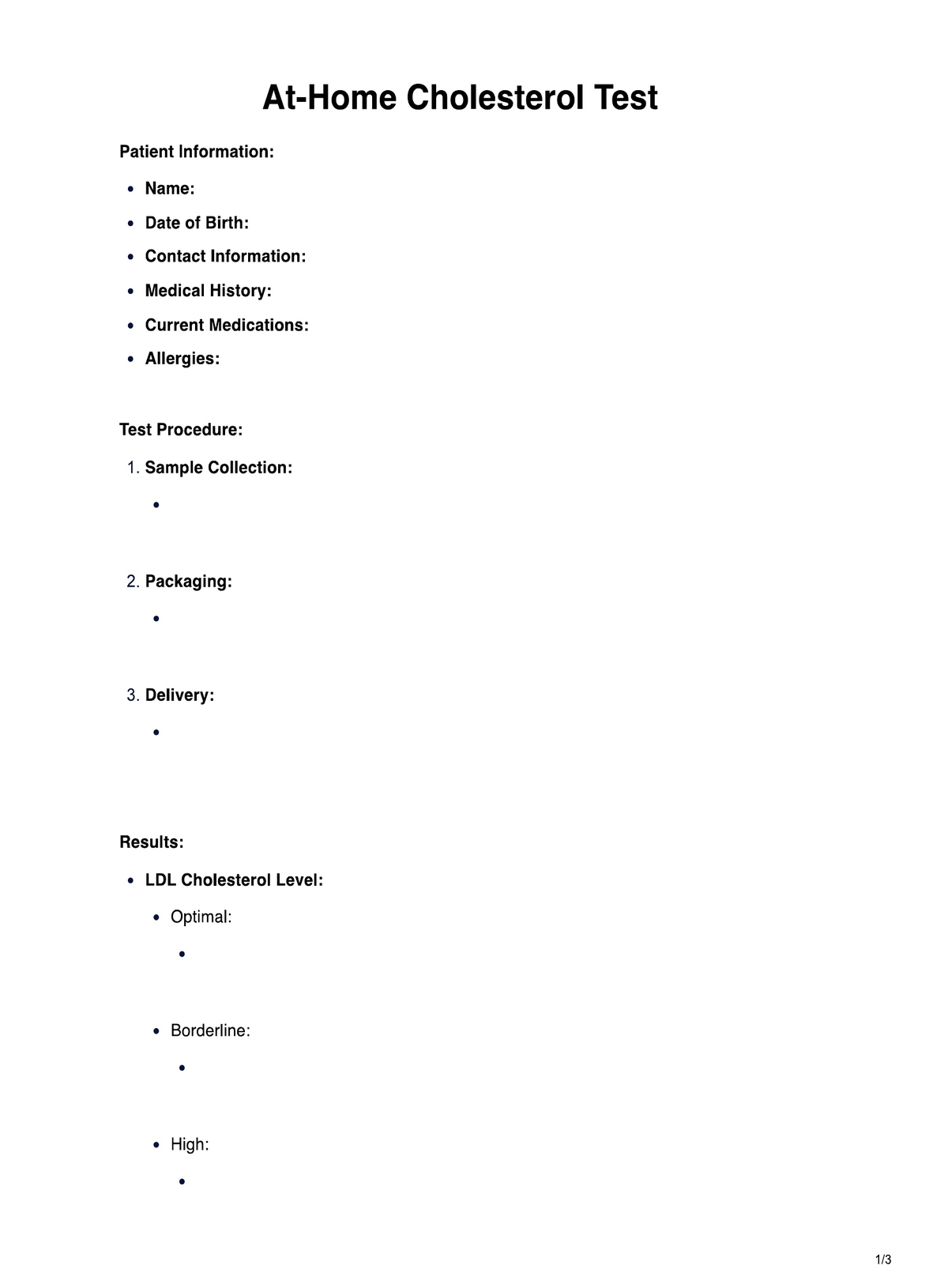Cholesterol Test Reports
Download a free Cholesterol Test Report template and easily document your patient's results. Get the PDF template and example now.


What is a cholesterol test?
A cholesterol test, also known as a lipid panel or lipid profile, is a blood test that measures the levels of fats (lipids) in an individual's blood. These include total cholesterol, high-density lipoprotein (HDL) cholesterol, low-density lipoprotein (HDL) cholesterol, and triglycerides expressed in milligrams per deciliter (mg/dL) or millimoles per liter (mmol/L).
The test is a simple blood draw, usually from the arm. To get accurate results, the individual may be asked to fast for 9-12 hours before the test. After the blood is drawn, it is sent to a laboratory for analysis. Results are typically available within a few days and may be recorded in a Cholesterol Test Report form. This information provides helpful data about an individual's risk of developing heart disease or other health conditions. It is recommended that adults over the age of 20 should have their cholesterol levels tested every 4-6 years unless they have certain risk factors that may require more frequent testing (American Heart Association, 2024).
It is worth noting that these numbers can then be compared to healthy ranges based on age, sex, and other risk factors, helping individuals and healthcare providers identify trends, assess risk factors, and make informed diet, exercise, and medication decisions.
Cholesterol Test Reports Template
Cholesterol Test Reports Example
How does it work?
Our printable Cholesterol Test Report PDF template makes recording and tracking your patient's test results easy. Follow these steps to get started:
Step 1: Access the free template
Download the Cholesterol Test Report using this page's link or the Carepatron platform. You may also check our Cholesterol Test Report sample for reference.
Step 2: Complete the patient's information
Enter the necessary details about your patient, such as their name, date of birth, and any relevant medical history.
Step 3: Record the test results
Document the total cholesterol, HDL, LDL, and triglyceride values. These can typically be found on the lab report provided by the testing facility.
Step 4: Interpret the results
Compare the recorded values to the healthy ranges based on age and other risk factors. This will help determine whether further action or additional testing is necessary.
Step 5: Provide recommendations
Based on the cholesterol report results, provide your patient with actionable steps they can take to improve their cholesterol levels and reduce their risk of developing heart disease or other conditions. This may include lifestyle changes, medication options, or follow-up appointments.
Step 6: Monitor and track progress
Encourage your patient to monitor their cholesterol levels regularly and track any changes over time. This will help them stay on top of their health and make informed decisions about their care.
When would you use this test report?
You can use the Cholesterol Test Report template for any patient undergoing cholesterol measurement or testing, whether a routine check-up or part of a more extensive health assessment. This template can help you:
Keep track of a patient's cholesterol levels over time
Our cholesterol lab report template lets you easily record and track a patient's cholesterol levels over multiple tests. This can help you identify any patterns or changes in their results, informing your treatment plan and recommendations.
Provide a clear and comprehensive report for your patient
The Cholesterol Test Report template includes all the necessary information to help you interpret the results and provide tailored recommendations for your patient. This can save you time and ensure your patient thoroughly understands their test results.
Collaborate with other healthcare professionals
You can also use this template as a communication tool between healthcare professionals. By sharing the report with other providers involved in a patient's care, you can ensure everyone is informed and on the same page regarding managing their cholesterol levels.
Enhance patient engagement in their health
The Cholesterol Test Report template can help engage patients in their health by providing easy-to-understand information about their cholesterol levels. This can empower them to actively manage their cholesterol and make informed decisions about lifestyle changes or medications.
Result components
When interpreting results, it is essential to consider all these components together rather than in isolation. Each component tells something about a patient's risk of coronary artery disease. You should consider other risk factors like age, family history, smoking, diabetes, and high blood pressure, as patients with multiple risks might need more aggressive treatment, even with borderline cholesterol levels. Let's take a look at the components and their implications:
Total cholesterol
This is the total amount of cholesterol in your patient's blood, including good (HDL) and bad (LDL) cholesterol. Generally, a total blood cholesterol level of less than 200 mg/dL is desirable.
LDL cholesterol
Often called "bad" cholesterol, LDL carries cholesterol from the liver to cells throughout the body. Too much low-density lipoprotein cholesterol in the blood can build up on artery walls, leading to a higher risk of heart disease. A desirable LDL level is typically less than 100 mg/dL.
HDL cholesterol
Known as "good" cholesterol, HDL helps remove excess cholesterol from the body and transport it back to the liver for processing. Higher levels of HDL are associated with a lower risk of heart disease. An optimal HDL level is typically above 60 mg/dL.
Triglycerides
Triglycerides are another form of fat found in the blood. Very low-density lipoprotein (VLDL) is made by the liver and carries triglycerides to your tissues. High levels of VLDL can cause plaque to build up in your arteries, leading to restricted blood flow. When triglyceride levels are too high, they can also contribute to heart disease. Normal triglyceride levels is less than 150 mg/dL.
American Heart Association. (2024, February 19). How to get your cholesterol tested. https://www.heart.org/en/health-topics/cholesterol/how-to-get-your-cholesterol-tested
Commonly asked questions
Primary care physicians, cardiologists, and other healthcare providers may order cholesterol tests as part of a routine check-up or in response to specific symptoms or risk factors. Additionally, individuals may request a cholesterol test on their own if they are concerned about their heart health or have a family history of high cholesterol.
Cholesterol tests can assess a person's risk of cardiovascular disease and guide treatment decisions. They may be ordered as part of routine health screenings or when a person is experiencing symptoms such as chest pain, shortness of breath, or fatigue. Additionally, cholesterol tests may be used to monitor the effectiveness of cholesterol-lowering medications.
A cholesterol test usually takes a few minutes to complete. The person performing the test will take a small blood sample, typically from a vein in your arm, and send it to a lab for analysis.
Yes, many resources are available online. In this guide, aside from a blank template, we've included a copy showing a patient's sample cholesterol test results to give you a clear idea of what to expect.












































































































